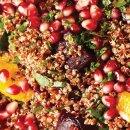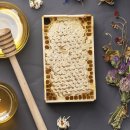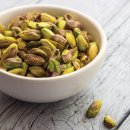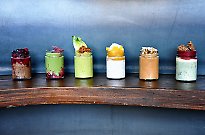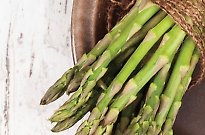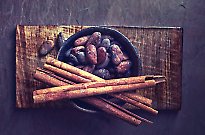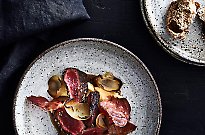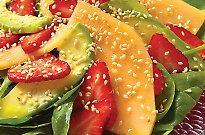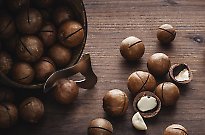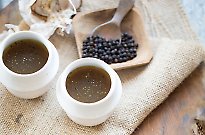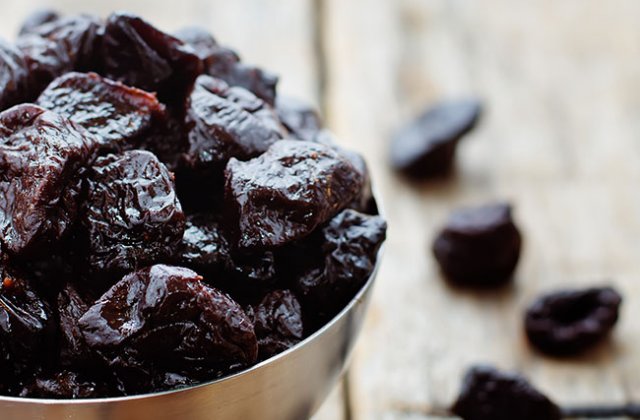
Trending: Super prunes
Trending: Super prunes

Prunes have a reputation for ‘keeping you regular’, and (perhaps infamously) being wrapped in bacon and served as an appetiser by the archaic name of ‘devils on horseback’. But these rich-tasting, high-fibre dried fruits have applications beyond the remedial and old-fashioned hors d’oeuvres.
What are prunes?
A prune is simply a dried or dehydrated plum. The variety most commonly grown in Australia is the D’Agen. Originally from France, the classic D’Agen remains the ideal plum variety for drying because of its high levels of natural sugars, the thickness of its skin, its ability to absorb liquid after drying and its intense flavour.
How are they made?
Plums ripen on the trees and when they are ripe and the sugar levels are just right, they are mechanically harvested by a shaker where the tree is shaken to release the fruit. The fruit is then collected by a receiver and fed into bins. Australian prunes are predominately dried on farms overnight in large hot-air tunnels. Picking and drying all takes place in a 24-hour period. Once dried, the prunes can be stored for up to two years. Many local prune products are also made exclusively with Australian prunes. Read labels carefully, to be certain you’re buying genuine Australian grown prunes.
Why are they good for you?
Aside from their value as a laxative, prunes are being hailed as functional food with a variety of benefits for a variety of chronic diseases and medical conditions such as heart disease, diabetes, osteoporosis and digestive problems. A Nutrition Data (nutritiondata.self.com) analysis of prunes found that, per 100 grams, prunes contain 74 per cent of the recommended daily intake (RDI) of vitamin K – a mineral that, according to Osteoporosis Australia, is vitally important for bone health. Vitamin K2 (a form of vitamin K) has been shown to slow down the rate of bone weakening after menopause and increase bone strength and may decrease the number of fractures in women with osteoporosis.
Prunes also contain around 16 per cent of the RDI for vitamin A (for eye health) and 21 per cent of your RDI for potassium (for heart health and blood pressure). Not only that, 100 grams of prunes contains five per cent of the RDI for iron and four per cent of the RDI for calcium – minerals usually found in meat and dairy – making them a powerful plant-based food for vegetarians and vegans.
Australian Prune Industry Association Chairperson Grant Delves says, “Prunes are one of the most versatile fruits available, they have a high natural sugar content making them a good substitute for refined sugar, they’re a great source of potassium, calcium and iron, and are low in sodium. And they are cholesterol and fat-free, high in fibre and have a high level of antioxidants.”
Weight loss studies have also made an argument for prunes’ impact on satiety. One such study by the University of Liverpool asked a group to eat prunes every day (140 grams a day for women and 171 grams a day for men) and gave others healthy snacking advice. The prune group lost more weight and reported more feelings of fullness than the healthy snacking group. And, perhaps more importantly, participants reported no negative side affects.
Fine dining foray…
Eschalot head chef Nick Gardner’s subtle touch with food and his respect for classic techniques have helped him make his mark when it comes to the fine dining sphere. But what happens when you hand him an ingredient that’s more known for naff appetisers than posh restaurant dishes? Nick worked with the Australian Prune Industry Association to create a series of stylish dishes with prunes at their centre. Many of which will be showcased at upcoming Good Food & Wine shows (goodfoodshow.com.au) across Australia throughout June, July and October. This swish seven-grain breakfast porridge was perfect for the immunity issue of nourish magazine.
Words: Maddie Lakos, The Australian Prune Industry Association.
Photography: Thinkstock, The Australian Prune Industry Association.



